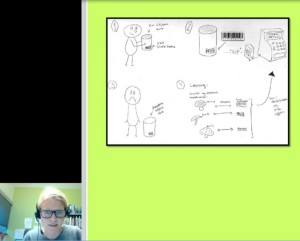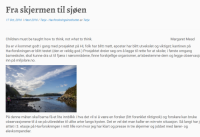Flipped out of flipped classrooms
This fall I rearranged my teaching from more traditional lectures to more student active learning. It was successful, the students appreciated it, and the learning outcome increased. I will surely do it again next year.
I am positive now, but honestly, if you had asked when I was actually doing all the needed preparation for the teaching, my recommendation might have been different. Because what I strongly recommend you to do (based on my personal experience), is to put yourself through several weeks with extra working hours and frustration. This is surely not a persuasive selling argument, but the take home message is “Do not give up, it is worth it”.
BioCEED believe in student active learning, and have arranged several seminars and work-shops to inspire biology educators to shift focus from ‘teaching’ to ‘learning’, and provide tools to facilitate student active learning. Last year I joined a workshop arranged by bioCEED, and I was introduced to learning activities called “Team-based learning” (TBL) and “flipped classrooms”. I became inspired indeed. I wanted to test out this efficient learning activity.
In short, the idea was that students should prepare themselves before coming to class, for instance through watching pre-recorded lectures, while the usual lecture time should be used more interactively. Thus, I had to pre-record my lectures.
However, I had no clue how I should prerecord lectures, and my workplace had no software available. I spent hours testing out various trail-versions, whereof none resulted in anything useful. Luckily, our librarian overheard me complaining about my recording-problems and offered me help. It turned out that she had her own YouTube gaming channel and knew which programs to use and how to use them. That was a break-through, and the technical part was solved.
 However, I realized rather quickly that to build up the lecture as I usually do was not optimal. According to literature, the ideal length of a lecture video is 6 minutes. I had to chop up my lectures in many smaller parts. And still I had a hard time making them short enough. Eventually, after many retakes and adjustments, I realised that my time was running out – I had to publish what I got. That was just painful. When you do a lecture live, you probably say something wrong from time to time, or you stutter a bit, but then it is gone and forgotten. Now it could be played over and over again.
However, I realized rather quickly that to build up the lecture as I usually do was not optimal. According to literature, the ideal length of a lecture video is 6 minutes. I had to chop up my lectures in many smaller parts. And still I had a hard time making them short enough. Eventually, after many retakes and adjustments, I realised that my time was running out – I had to publish what I got. That was just painful. When you do a lecture live, you probably say something wrong from time to time, or you stutter a bit, but then it is gone and forgotten. Now it could be played over and over again.
At this point I had spent all extra time I had set aside to prepare my teaching. Unfortunately, the content of the actual lecturing time, the questions and the case-studies we were supposed to work with, were still lacking. I worked many late nights to pull everything together, and the quality was thereafter. I was rather nervous the first day, but after seeing the students working in the classroom; discussing, debating, and asking questions, I was convinced. My pre-recorded lectures and case-studies were fare from being perfect, but they worked.
I think bioCEED have inspired many educators to change their teaching methodology. I also think some of these inspired educators have realized (me included) that testing out new methodology can be easy in theory, but rather difficult in practice. So to all of you out there trying to improve but feeling you are hitting the wall: Well, you are not. You do a great job bringing us forward. We will never improve if we do not dare to step out of the comfort zone.
Pernille Bronken Eidesen
Associate professor at UNIS and Deputy leader BioCEED




1 Response
[…] Read more about one of our bioCEED team members’ experience with recording lectures click here. […]